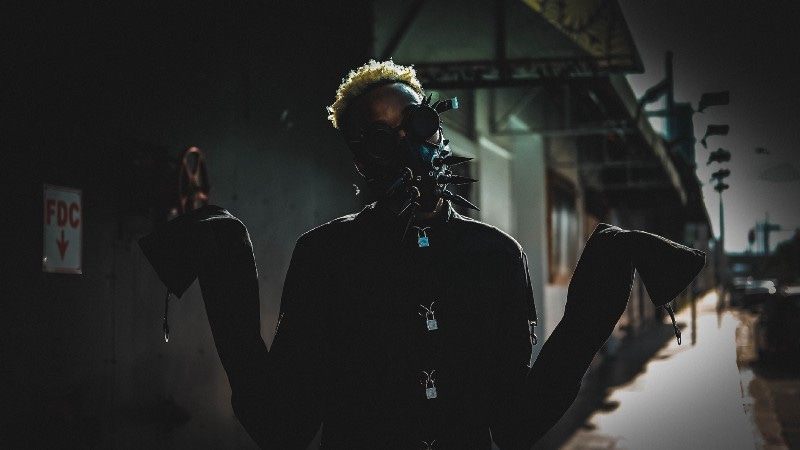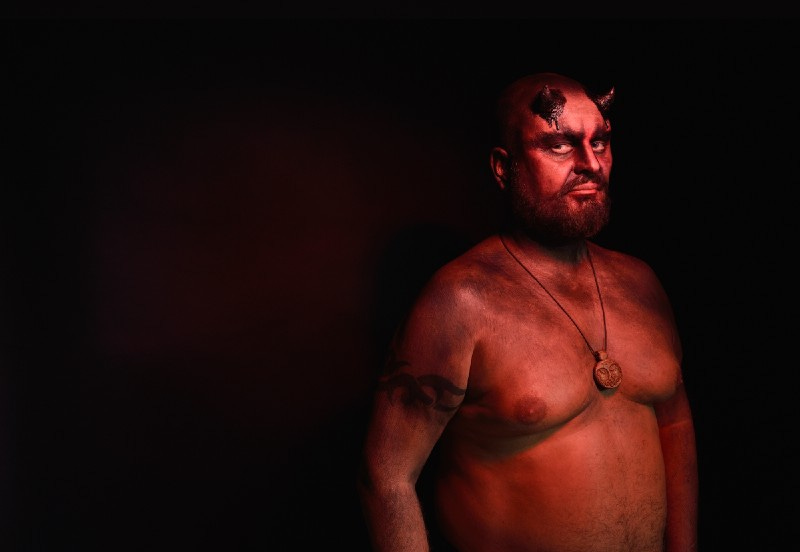Adopting the aesthetics of evil as a gesture of queer pride.
Much has been written about the problem of queer-coded villains. For most LGBTQ people, our first glimpses of self-recognition in media are also major vectors of shame. Many writers have explored how these glimpses harm us, how they taught us to associate our identities and desires with danger.
Comparatively little, however, has been written about being a queer person and choosing to villain-code yourself. This is a phenomenon I have witnessed in dozens of lesbian, gay, trans, bisexual, and asexual friends over the years, and one I experience personally as well. Looking like a bad guy is a huge part of queer aesthetics and fashion. It’s a powerful form of LGBTQ defiance. It’s a way to co-opt the horror and stigma that society has foisted upon us, to render it glittery and glamorous.
Villain-coded queer people cover ourselves in black and adorn our clothes with spikes; we cover our eyes and lips in dark shades and glare at everyone we presume to be straight on the bus. We long for capes, vampire teeth, and red contacts that suggest demonic possession. We admire the glamorous, comfortable lives of fictional gay supervillains, who live on the fringes of society but look damn good doing it. We want to be scary. We want to put people off. We are done seeking mainstream approval. We want what Hannibal Lecter and Villanelle have.

The queer-coding of villains, it turns out, is a two way street. Media creators tried to make their antagonists seem especially menacing and strange by giving them queer traits, but queer people in turn learned to embrace their identities and flout society’s conventions by coating ourselves in villainy.
After years of being told by your favorite shows, movies, and books that there is something fundamentally yet unnamably wrong with you, sometimes you decide to stop fighting the perception and just give in to the supposed darkness. Sometimes you wear the mask of evil as a form of armor, to protect yourself from the reproach and rejection of the cisgender, heterosexual world.
I’m a villain-coded queer. I find strength and self-acceptance in identifying with effete, perverse, gender non-conforming villains. It might not be the healthiest coping mechanism. It’s definitely an ambivalent and flawed path to self-love. But for me and a lot of other queer people who have been consumed with shame for most of our lives, it’s one of the most powerful options we have.
…
The first queer-coded villain I remember attaching to was Scar in The Lion King. I loved the way he sashayed and rolled his eyes at his boring, tradition-minded, painfully straight family. I loved that he was isolated and bitter but couldn’t stop throwing out dry witticisms that his normie relatives failed to appreciate. I loved that he looked different from the other lions — darker, more sickly, the consumptive goth in a community of sunshine-hued jocks. I was already the certified freak of my family and school, but Scar made it seem like that could be a cool thing.
I loved Scar so much that when my church choir decided to allow the performance of secular music, I suggested we sing Scar’s iconic villain song, “Be Prepared”. A malevolent-sounding, droning song about fratricide that features an army of hyenas literally goose-stepping. The choral director was understandably not interested in having a bunch of ten-year-olds sing a militaristic murder song in church. At the time, I utterly failed to understand why.
In that moment, and in many moments to come, I experienced the alienation of taste that often defines queer life. I was young and naive, proudly adoring something unconventional in a passionate way because it made me feel seen. Yet the moment I shared that love with everyone else, I learned there was something deeply wrong with it, but no one would explain to me what it was.
It was a small event, yet it made me start to wonder what was wrong with me. It made me question my judgement and my passions. And it started me on the path of wondering if I, like Scar, was evil at my core.
…
On Kim Possible, the villain Shego is obsessed with the show’s titular hero, Kim. She’s fixated on her rival, creepily so, obsessively so, in a manner that is both loathing and love. She is also super well dressed and smart and hot as hell.
I’ve heard several lesbians and bisexual women say they adored Shego, identified with her and resonated with her and Kim’s sexual tension. Many of them also grew up fearing they would be seen as predatory, invasive, or obsessive for their interest in other women. The same character who brought them comfort also encouraged them to develop a deep-seated mistrust of themselves.
When I asked my Instagram followers who their favorite queer-coded villains were, the same few characters kept coming up repeatedly. Ursula is a confident, strong-willed, fat butch woman that means a ton to lots of queer women and fat people. She also scams and imprisons people, robs women of their beauty and talents, and tries to murder them. On The Powerpuff Girls, HIM is a gorgeous icon of glorious gender-fuckery. He’s also the literal devil. In Pocahontas, General Radcliffe glitters and prances about as he extols the virtues of genocide.
People find these villains compelling for lots of reasons — almost all of them are deeply charismatic and fashionable as hell — but queer kids love them in particular because we see hints of ourselves. When you’re a closeted queer kid, these characters are a spoon full of poison laced with sugar. Loving them hurts us, but we can’t resist, because they taste so damn good and we are absolutely starving.
Fabulously Fiendish: Disney Villains and Queer-Coding
Most of what I know I learned from Disney films. A dream is a wish your heart makes, we are part of the circle of life…www.marginsmagazine.com
As queer adults, we can rethink the ways in which these media depictions hurt us. We can attempt to separate the shame from the self-recognition, swallowing just the sugar and slathering our bodies in a protective coating of poison instead. This is exactly what being a villain-coded queer is all about. Like poisonous animals that scare away predators with their distinctive appearances, we use bright, eye-scalding colors, dark, drapey fabrics, and punky, aggressive accessories to signal that we are just fine without your approval, thank you very much.
…

Many of us have spent decades trying to avoid the queer things about us — the things that made us seem villainous. Don’t sit in a ‘masculine’ way. Don’t bend your wrist. Don’t gaze in the Victoria’s Secret window for too long. Don’t wear that dress. Hide these strange things about yourself, your very existence is making other people feel unsafe.
Once we come to realize that our true selves were never evil, and never needed to be hidden, we start to question how society went about determining what good and bad even are. Why is black the color of malevolence? Why do scheming bad guys so frequently have hooked noses and coiled hair? Why are so many villains physically disabled and bitter about it?
Do we really want to avoid being associated with these tropes? Do we want to distance ourselves from the villified? Or do we want to embrace them and their aesthetics, spitting in the faces of the people who isolated us, shamed us, and told us to be normal and nice?
…
Queer-coded villains typically have a regal self-assurance that closeted LGBTQ folks covet like nothing else. They are worldly and powerful, even though society has rejected them. They dress in unique and distinctive ways, but instead of getting beaten up on their walk home from the bar, they inspire a kind of terror that sorta looks like respect.
I have always admired Hannibal Lecter —even though he tortures his psychiatric patients and eats them. I like that he is a queer-coded character who thrives despite how deeply broken the books imply he is. I admire Hannibal’s effete qualities, his refusal to temper his extravagant taste for the sake of placating other people. He is deeply private and independent, with a rich inner life and an endless capacity to keep himself entertained. He will never belong among average people, but he built an interesting, enjoyable life for himself despite that. And in the Hannibal show, at least, he managed to find an adoring murder-boyfriend.
In real life, queer people are frequently rejected by their families and communities and end up living in poverty. Queer-coded villains, in contrast, may also be very alienated from other people, but enjoy tons of creature comforts and wealth despite that. Real-world queer people toil in lonely isolation; queer-coded villains relish their solitude, or have armies of adoring sycophants. Actual queer people live in obscurity and marginalization; queer-coded villains are infamous and hyper-visible. Real queer people fear their own sexuality and are pressured by society to hide it; queer-coded villains are openly, joyously lascivious and sexual without hesitation.
Can you blame us for trying to embody their grandeur? For deciding to pretend that we are evil and scary and all-powerful, because that is the primary form of queer power we’ve ever seen?
…
There is a viral tweet that I just adore, which compares the immense, winning confidence of comedian and influencer Rickey T to the self-assured villain of Dragonball Z, Vegeta. Rickey T is a young, gay, Black man who exudes charm — his tone of voice is almost always extravagant and regal. It’s no wonder that someone thought to jokingly compare him to a famously self-aggrandizing villain.
This comparison was clearly not intended to demonize Rickey T, by the way. It was a celebration of the vast inner strength you see in confident queer people and queer-coded villains alike. Unfortunately, you rarely see LGBTQ characters in media who both exude confidence and are portrayed as morally good.
When I’m trying to boost my own confidence and remind myself that it is okay for me to exist in public as a trans person who does not pass, I tend to imagine that I’m Scar, or Hannibal, or Revolver Ocelot. I don’t imagine that I am one of the rare good queer people I’ve seen in media — the apologetic, ashamed David of Six Feet Under, the goofy, sensitive Daryl Whitefeather of Crazy Ex Girlfriend.
If I want to be confidently me, I have to aim for a caricature of deluded, selfish hyper-confidence — because my actual self-esteem is so low that any amount of self-assurance feels outrageous and disgraceful. I have to embrace being mistaken for evil to even feign a baseline level of self-love.
…
Society has taught me to hate the things about myself that flout heteronormative expectations. I feel guilty for destroying my “beauty” by transitioning. I feel like not wanting children makes me a literal demon. I have tried for so long to hide so much. I have been told so much of me is rotten and corrupt.
In my moments of deep despair and self-loathing, queer-coded villains are there for me. And, increasingly, so are the real world’s villain-coded queers. When I look my most fearsome and malevolent, I feel the most normal and OK. When I give up trying to conform, I feel the least like I have something to hide.
There is great power to be had in dropping the mask of heterosexuality and donning a scarier mask instead. A mask that pushes away the people whose approval I used to harm myself trying to earn. It is only by rejecting cishet stereotypes of goodness and purity that we can recreate the world, reshape it into a more welcoming and tolerant place. Queer-coded villains may be trying to destroy the world, but villain-coded queers are simply adopting their aesthetics in the hopes of saving it.



